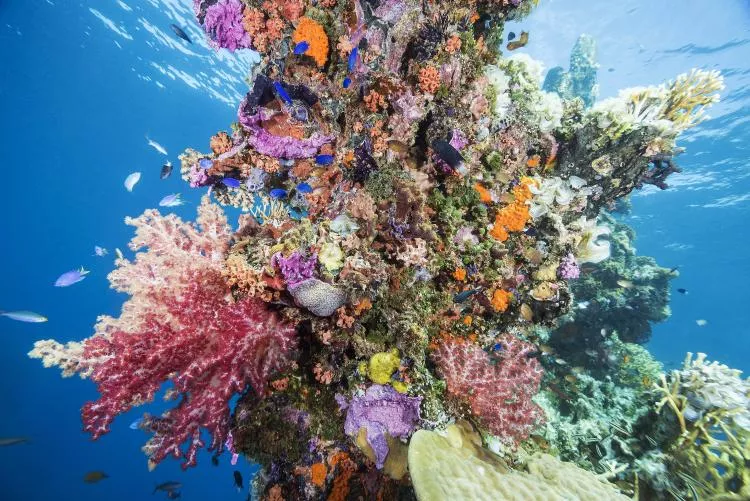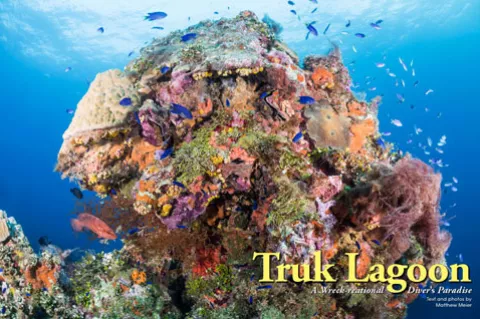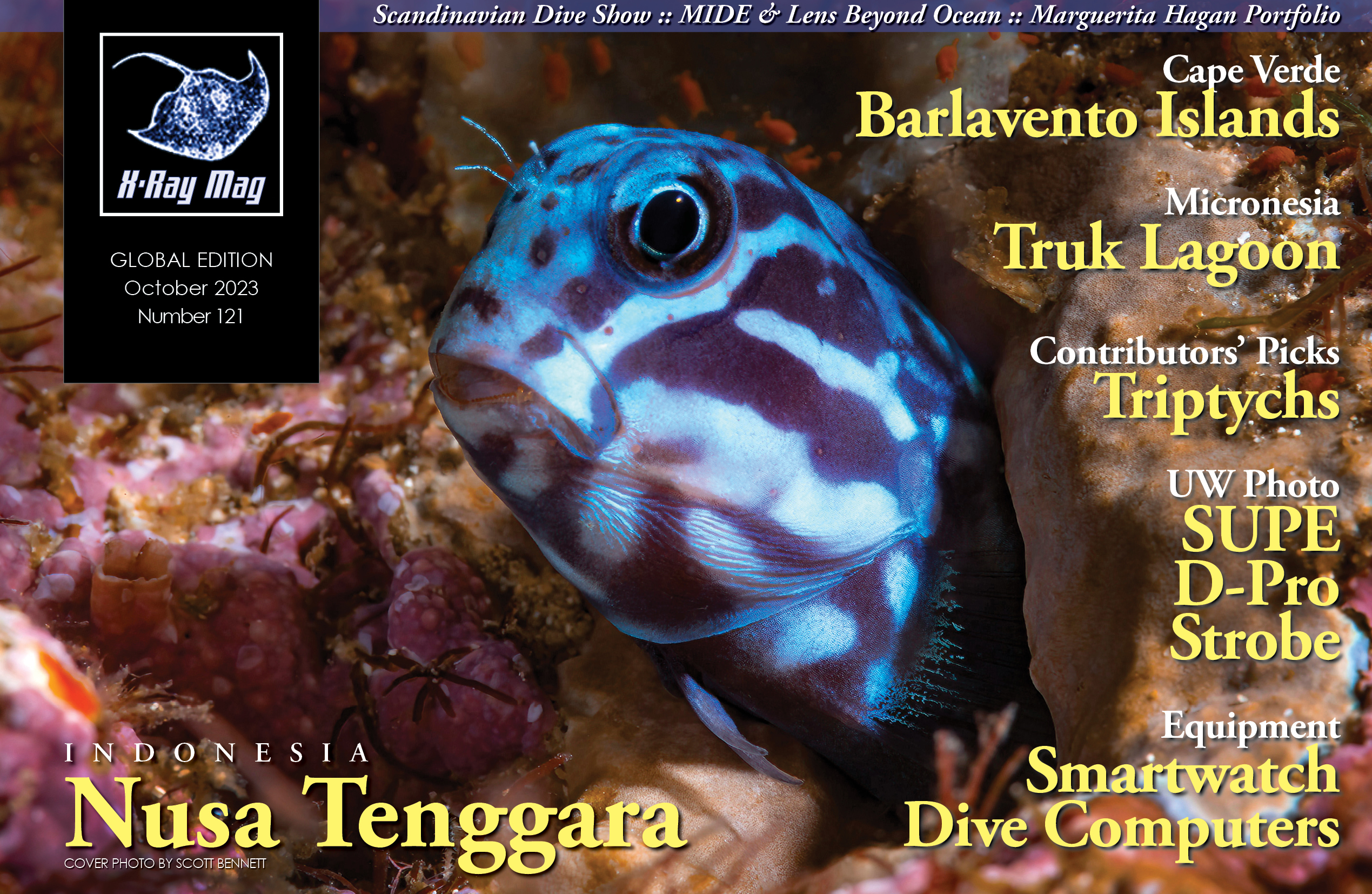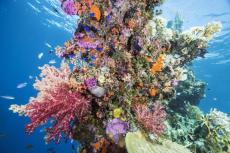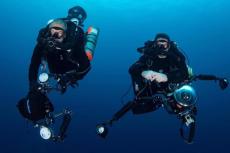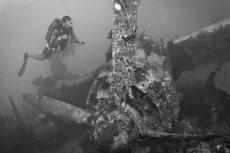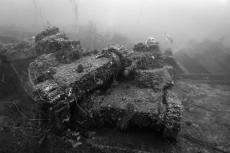Picturesque, remote tropical islands, a serene, protected atoll, endless warm water, colorful soft corals, encrusting sponges, schooling reef fish and the occasional spotted eagle ray, shark or other pelagic… What more could a diver ask for? How about over 60 shipwrecks, plane wrecks and even a submarine steeped in WWII history—95 percent of which are within recreational diving limits. Contrary to what you may have heard, Truk Lagoon is definitely not just for the technical diving community. Matthew Meier shares his adventure there.
Contributed by
Considered by many to be the wreck diving capital of the world, Truk Lagoon has been on my proverbial bucket list for years, so when the opportunity arose to visit this faraway corner of the planet, I jumped at the chance. Some readers may remember my article on diving the Solomon Islands in issue 85; I have an affinity for WWII history in the Pacific theater, and thus, was very excited to see Truk for myself.
History
The Japanese utilized Truk Lagoon as a staging area for their war efforts during WWII, transporting ships, planes, supplies, munitions and fuel; they even performed repairs in its protected waters. Through airborne reconnaissanceefforts, US forces ultimately discovered that Truk was Japan’s largest military base and plans for an attack began in earnest. On 17 and 18 February 1944, more than 500 US warplanes carried out a devastating assault in what was known as Operation Hailstone.
The planes were launched from five aircraft carriers and another four light carriers, supported by a multitude of battleships, cruisers, destroyers and submarines. Pilots used bombs and torpedoes to target ships at anchor during their initial attack on the 17th, as well as concentrating on the five airstrips and seaplane bases that had been constructed on various islands, in an effort to limit Japan’s ability to launch planes into the air for their own defense. Fuel and munition bunkers were the primary objective on day two, since destroying these earlier would have resulted in expansive plumes of smoke and hindered the pilots’ ability to sight in the ships. The strategy and execution were so effective that the planned third day of shelling was essentially deemed unnecessary.
The Imperial Japanese Navy lost dozens of ships, hundreds of planes and thousands of lives over those two days, hampering the efforts of their remaining troops spread out across the Pacific. Many of the sunken vessels were merchant ships, and per Japanese naming convention, they were given a name that ended with “Maru,” which translates to “circle”. The name was meant to bring good fortune, in hopes that each vessel would be able to leave port, navigate to its destination and return home safely, completing the circle.
The wrecks
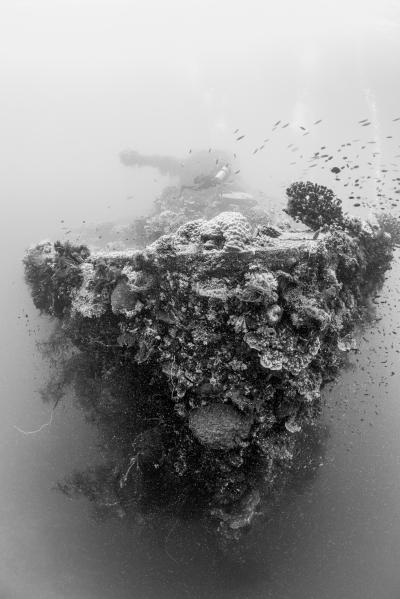
The majority of the wrecks in the lagoon are concentrated in three separate anchorages, in relatively close proximity to one another, and are accessible by no more than a 15- to 40-minute boat ride from shore. After nearly 80 years underwater, there is significant growth on many of the shipwrecks (especially those at shallower depths) and impressive amounts of sea life living on these unintended artificial reefs.
The location
Situated in the western Pacific Ocean, roughly a two-hour flight from Guam and about halfway between the Philippines and Hawaii, Truk Lagoon is found in the country of the Federated States of Micronesia (FSM). Comprising more than 600 islands, FSM is made up of four island states known as Kosrae, Pohnpei, Yap and Chuuk. The latter is also used as a spelling for the lagoon, and you will see and hear the area referred to as both Truk Lagoon and Chuuk Lagoon. It was explained to me that “Chuuk” is most commonly used when referring to the land or state itself within FSM, and “Truk” is more frequently used when speaking of the lagoon and the dive sites therein.
Getting there
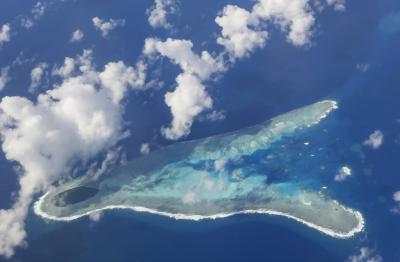
United Airlines is currently the only air carrier with flights from the United States to Micronesia, offering two different routes, each includes a stopover in Hawaii. Traveling from the West Coast, our journey began with a 9 a.m. departure from Los Angeles, followed by a short layover in Honolulu, before flying directly on to Guam.
Arriving a little after 7 p.m. local time, we took a shuttle to a hotel for a few hours’ sleep before our 8 a.m. flight to Truk the next morning. Since our layover was over 12 hours, regulations stated that checked bags had to be collected in Guam and could not be tagged directly to our final destination. However, once in Guam, airport personnel informed us that bags could be checked in up to 12 hours in advance for our morning flight.
PRO TIP: To avoid dragging luggage to a hotel for the night, walk the bags upstairs and re-check them to Truk after passing through customs, as you will now be inside that 12-hour window.
For those returning on United to the United States via Guam at the end of your Truk adventure, this flight path also currently requires an overnight stay. Thankfully, the airline is accommodating on when you make that next flight to Hawaii. So, if you have the flexibility, stay and spend a few days on Guam. We had a lovely time enjoying its white sandy beaches and snorkeling the marine reserve right in front of our hotel. Plus, the adjusted schedule made for a shorter Hawaii connection and a quicker trip back to Los Angeles.
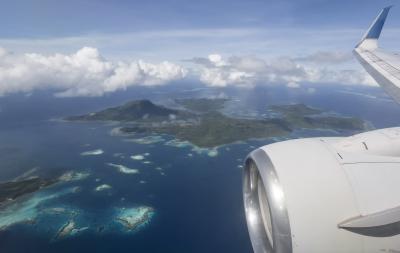
Dubbed the Island Hopper, this alternate route was established in 1968 and has been operating continuously ever since. Originally serviced by Air Micronesia, a subsidiary of the now defunct Continental Airlines (which merged with United in 2012), the flight operates three times per week from Honolulu to Guam and from Guam to Honolulu, with sojourns along the way in the Marshall Islands and FSM. The total travel duration, including time on the ground, is 16 hours end-to-end and includes stopovers at Majuro Atoll, Kwajalein Atoll, Kosrae, Pohnpei and Chuuk.
For many of these destinations, this was their only scheduled air service, and for travelers, this was a great way to see more of the islands. Our flight the next morning from Guam to Truk was actually the first leg of the Island Hopper, effectively meaning that at this time, there were only three flights per week in or out of Truk Lagoon. For international travelers, there were various airlines that could deliver you to either Hawaii or Guam; but ultimately, you would connect with one of these United flights to get to Chuuk.
As with any remote travel, especially when boarding a liveaboard dive boat that may or may not be able to return to port to collect a late arrival or missing luggage, it is advisable to arrive a day or two ahead of time to prevent unforeseen travel delays from disrupting your vacation. I also highly recommend purchasing travel insurance to help recover expenses when things do not go as planned, despite one’s best intentions or due to Mother Nature herself. In the case of Truk, with only three flights per week, that might mean arriving up to three days early.
We touched down at the airport on Weno Island, the capital of Chuuk, on a Thursday morning well in advance of our Sunday afternoon departure on the Pacific Master (masterliveaboards.com). The idea was to decompress for a few days, allow our bodies to adjust to the time zone change, and explore some of the WWII sites on land.
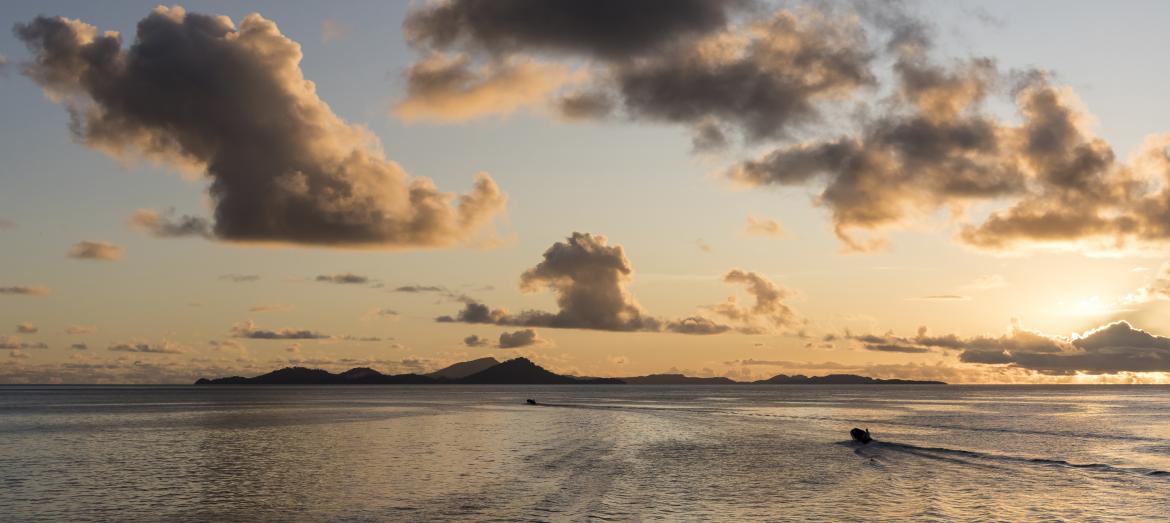
The resort
Truk’s first dive operator, Blue Lagoon Resort, sat at the far southwestern end of the island. This rustic, though newly renovated property, would serve as our home base for the next three days. Founded in 1973 by the late Kimiuo Aisek, a pioneer in the dive industry of Truk Lagoon, the resort was nestled amongst swaying palm trees, with stunning water’s-edge views of the lagoon. It is still a family-run resort.
The Kimiuo Aisek Memorial Museum was opened on site in his honor back in 2014 and is a must-see during your visit. The space was filled with WWII artifacts, along with historical pictures and stories from the wrecks in the lagoon, most of which Kimiuo located or helped to locate after witnessing their destruction in person as a teenager. There were several other relics scattered around the grounds, including an impressive concrete and stone pillbox looking out over the lagoon, which was constructed by the Japanese to help fortify the island.
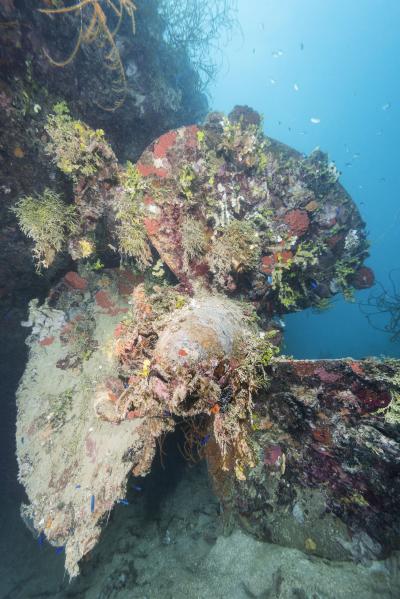
The liveaboard
We were joined by several other guests from the hotel as we transferred by skiff to the waiting ship tied to the dock in the commercial harbor. Liveaboard life began as we unpacked personal items, organized dive gear and assembled underwater housings in-between filling out paperwork, checking dive cards and listening to the always crucial boat and dive safety briefings.
There was a good mix of recreational and technical divers, primarily from the United Kingdom and the United States, plus one solo traveler from Hong Kong, among the group. Dive setups ranged from rebreathers to twin tanks with bailout bottles, to us recreational/no decompression divers on single tanks of nitrox. Divers must be at least advanced-open-water certified to dive Truk, and a deep diving specialty to 40 m (130 ft) is highly recommended.
One gentleman was here for the fifth time, having had such a fantastic experience on his first trip that he went home and become rebreather certified, so he could spend more time on each dive exploring the wrecks. His interest lay primarily in the wrecks themselves and their WWII history, as he frequently lamented the “bio-clutter” obscuring his view after a dive—a term I am absolutely stealing whenever discussing vivid soft corals and plentiful fish life, moving forward! Sadly, I have zero chance of properly imitating the fabulous British accent with which my new favorite phrase was originally uttered.
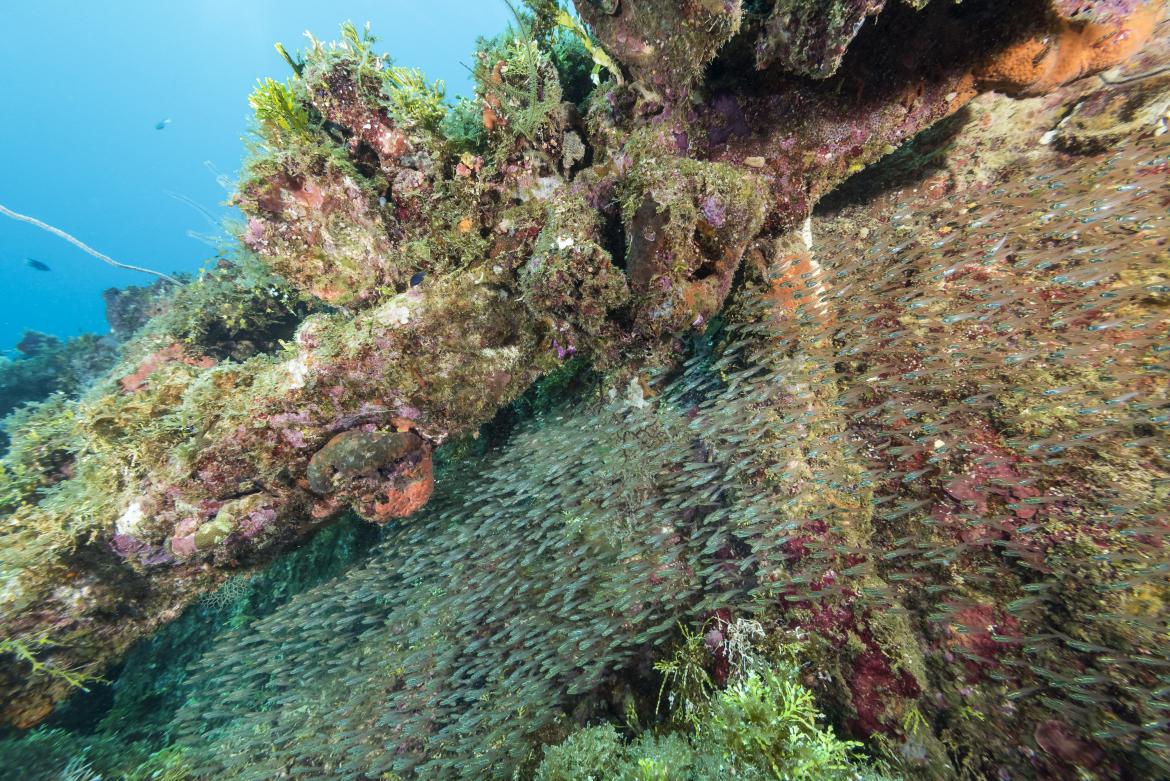
Diving
Truk Lagoon is one of the few places I have visited where a large number of the same dive sites are accessible by both liveaboard and land-based dive operations. The advantage of being on a liveaboard is the ability to wake up, enjoy breakfast and be already moored directly above a wreck for the first dive of the day. Afterwards, you can relax on your surface interval while the crew positions the boat for the next dive —you would not have to worry about long transits on small boats to and from each dive spot.
A liveaboard also has the ability to visit shipwrecks that are too far to reasonably dive from shore and access the coral reefs around the edge of the atoll. Depending on the site, both recreational and technical divers can explore the same wreck at different depths, or one group can take a short ride on a skiff to dive a more appropriate site nearby.
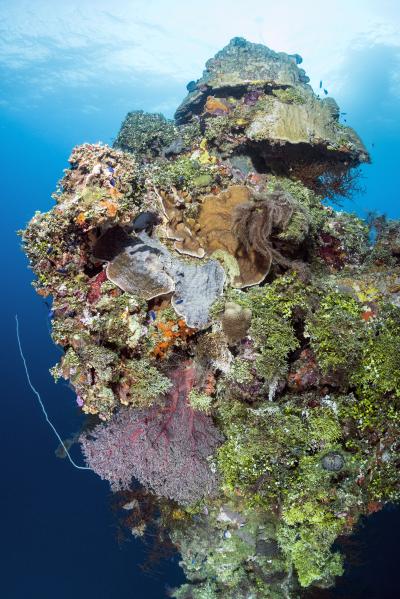
Due to extended bottom times, deco stops, and no small amount of precaution given the remote location, technical divers are limited to only one morning and one afternoon dive per day. On the other hand, recreational divers can typically get in three to four dives daily, at least when diving from a liveaboard.
There are far too many memorable wrecks to make mention of them all here, but I thought I would detail a few of the more famous one, the must-see spots, and perhaps one or two of my favorites from the trip.
Fujikawa Maru. The Fujikawa Maru is a 132m (433ft) former cargo and passenger carrier built in 1938, now sitting upright in 39m (128ft) of water, that falls into all three of the above categories. It was fitted with 6-inch (15.24cm) bow and stern guns when the Japanese thrust it into service in 1940, both of which are thoroughly covered in bio-clutter.
A brass plate is still visible at the rear of the bow gun, displaying its serial number and “1899” manufacturing date. Two separate holds are filled with supplies, munitions and airplane parts, including the fuselage of a Japanese “Zero” fighter plane, wings, wheels, nose cones and tail assemblies, in addition to hundreds of glass sake bottles. Several mechanical rooms and the engine room are accessible and mostly intact, with gauges and instruments on display, including one of the more famous air compressors in Truk Lagoon known as “R2D2.”
As I ascended to our safety stop alongside the king posts, which top out at only 9m (30ft), I marveled at the incredibly colorful coral and sponge growth concealing nearly every aspect of the metal structure. We split the hull between the bow and stern over the course of two dives but could easily have spent multiple days exploring the intricacies of this fascinating shipwreck.
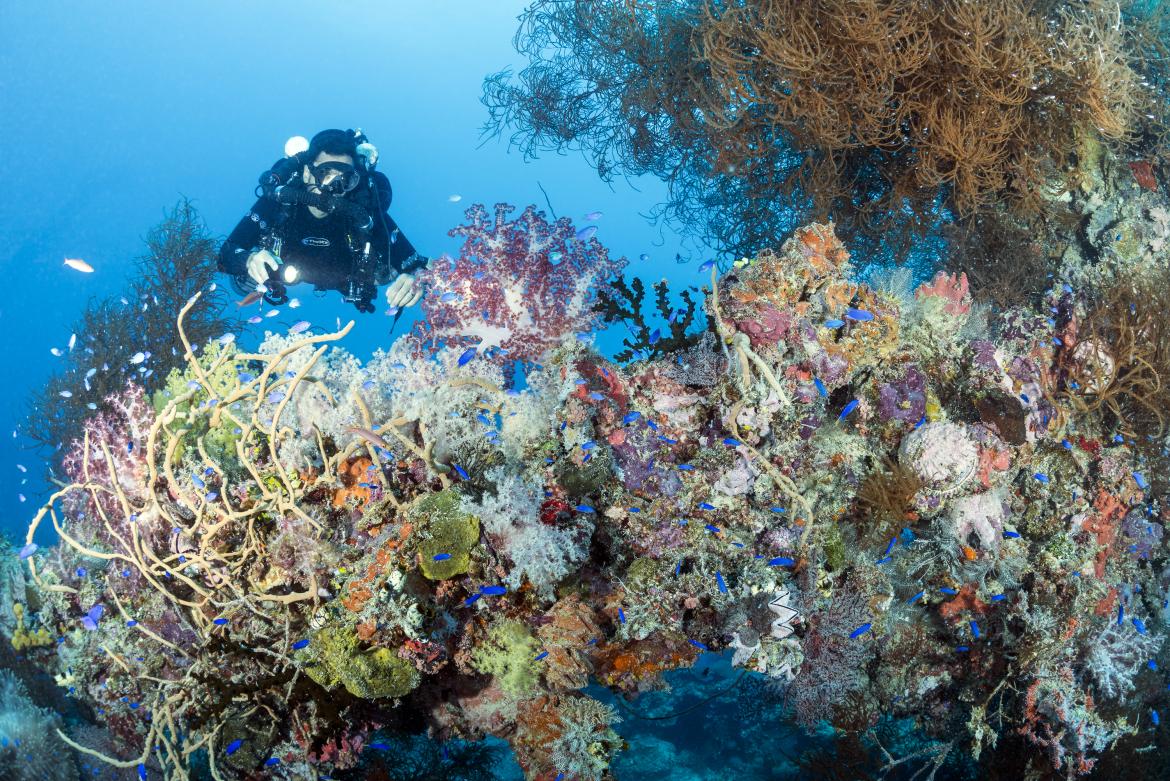
Shinkoku Maru. Resting upright at a similar depth, the Shinkoku Maru was a 152m (500ft) former oil tanker that is a must-see for its array of artifacts, accessibility, vibrant marine life and its immense size as the second-largest vessel in the lagoon. A kaleidoscope of colorful soft corals and sponges encased the elevated walkway above the deck, which sat at around 18m (60ft) and was still open inside to allow divers to swim the length of what was once a passageway.
A spare propeller blade remained strapped to the wall of a storage room near the entrance to the cavernous upper engine room, with still-functional staircases and an impressive-looking fuel transfer pump. Engine order telegraphs, which the pilot once used to communicate orders for speed and direction to the engine room, were still intact and encrusted with sponges at the bow, stern and bridge. In the forward superstructure, there were washrooms with tile floors and rows of urinals attached to the wall, plus rooms with operating tables, med kits and medicinal glass bottles.
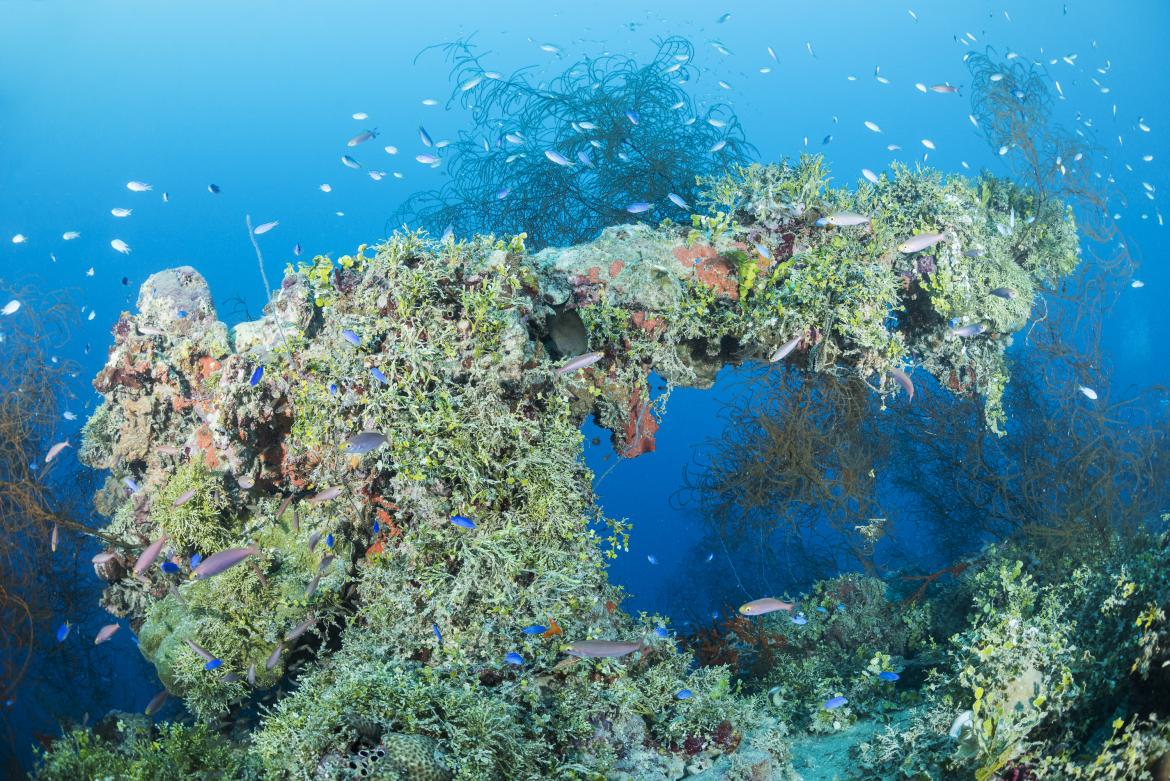
Kensho Maru. The upper engine room on the Kensho Maru was perhaps the largest interior open space I experienced during my trip. With a ceiling height of over two stories, divers could access this massive complex by slipping through the open skylights aft of the superstructure. Companionways and staircases led farther into the ship and down to the lower engine compartments where immense crescent wrenches were all neatly hanging on the wall, right where the engineer left them nearly 80 years ago.
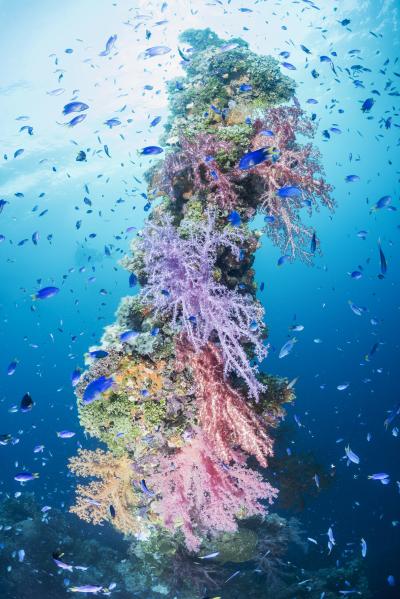
Scattered around the deck near the entrance to the engine room were hundreds of artifacts deposited by divers from years past, including porcelain sinks, rubber boots, lanterns, glass bottles and even a typewriter, with only the keys “I” and “O” enduring. This 117m (384ft) former cargo and passenger ship, which rested at 38m (125ft), had a 3-inch (7.62 cm) forward gun that was fully engulfed in corals. The king posts were decorated with a lurid rainbow of soft corals and surrounded by a school of goldtail demoiselle fish, creating one of my favorite photos from the trip.
Plenty to see
As I allude to the various features of particular wrecks, I feel I should also mention that for those who are not comfortable penetrating or being in a confined or overhead space, it is certainly not a requirement for enjoying your time in Truk. There is so much marine life on many of these ships, including scattered artifacts and other points of interest on the exterior, that venturing inside is simply an added bonus for those with the experience and expertise to safely navigate the inner workings. Most of the vessels in the lagoon are well over a football field in length, and it would take days to thoroughly examine their external surface.
A typical dive day for the recreational divers consisted of a 6 a.m. wake-up call, a light breakfast and a dive briefing for Dive 1. A full breakfast and a rest period followed the dive, along with the briefing for Dive 2, often on the same wreck but focused on a different area. Another surface interval and lunch back on board accompanied the third dive briefing, and then there was frequently a visit to a different wreck for the afternoon. If time and conditions allowed, a fourth dive was briefed after another break and planned for late afternoon. Each dive was led by a guide, though we had a bit of freedom to explore with our dive buddies, so long as we did not lose track of the group.
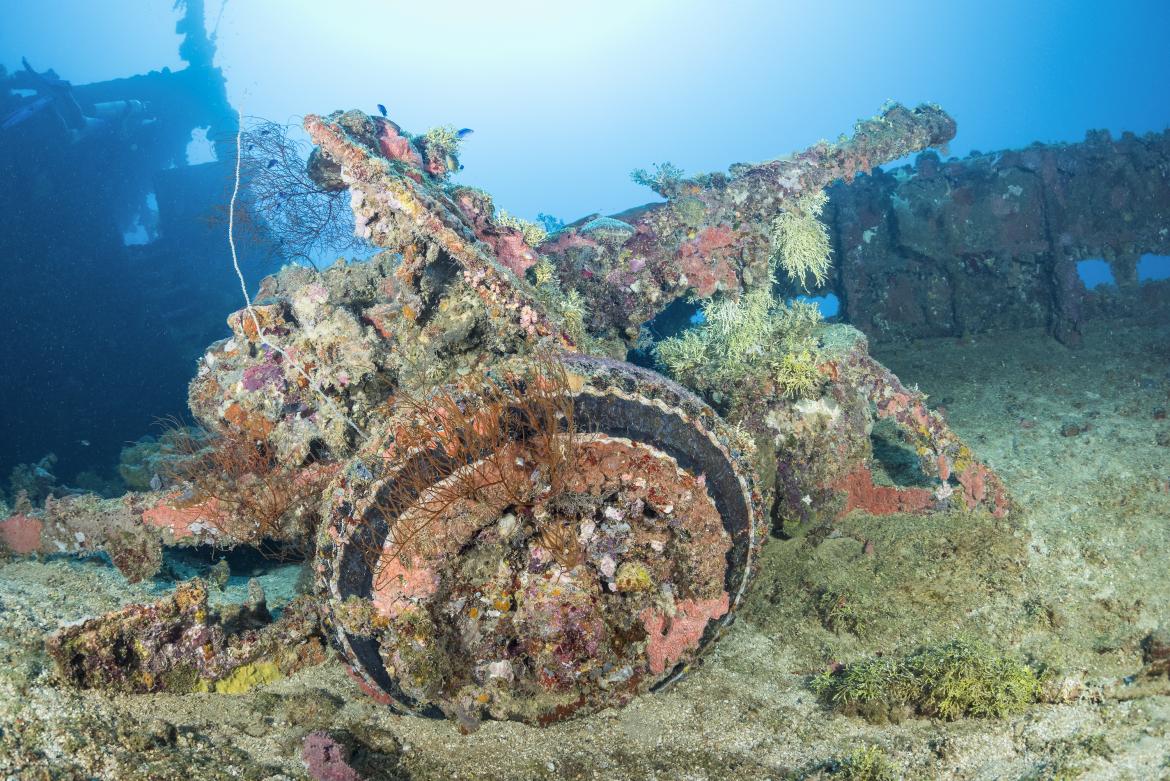
Nippo Maru. Sitting upright and listing slightly to port at 48m (157ft), the Nippo Maru was a wreck on which recreational divers could only go slightly past the deck, but there was still a great deal to see. Just in front of the superstructure, on the port side, sat a Type 95 Japanese tank, mysteriously missing its turret, and closer to the forward hold was a well-adorned truck chassis, balancing precariously over the edge. Inside the hold, gas masks, ammunition, bottles and other fascinating artifacts could be found. But beware: Just don’t lose track of your depth.
Aft, on the deck near the rear hold, were several field artillery guns, with their rubber tires still in place albeit decorated in sponges and corals. Coming shallower, towards the end of the dive, the bridge has a well-preserved steering helm, complete with the brass ring from the steering wheel and the engine order telegraph in the background. Here again, the king post was full of life, though not as easy to scale, given a slight current and the mooring line leading upward and away from the starboard deck. On both dives here, we encountered spotted eagle rays and a large school of barracuda swimming in the blue.

Japanese submarine I-169.
I would be remiss not to mention the I-169, one of only three known dive-able Japanese submarines in existence. Originally, 102m (336ft) long and 8m (26ft) wide, it currently rests in 42m (138ft) of water, with its shallowest point at 30m (99ft).
It sank in April 1944, in a follow-up attack of Truk, due to a diving accident in which not all its hatches were closed as it submerged to escape the bombardment. The crew was able to seal off the water-filled compartments, but the vessel could not be raised, nor was a rescue possible, and all on board perished. Their remains were the first to be recovered by the Japanese in the 1970s. It was a somber reminder that the wrecks in Truk Lagoon were all part of a mass war grave.
The forward section of the sub was later blown apart by depth charges, though it remained largely intact from the conning tower to the stern. Penetration was not possible, yet there were a few places where one could peer inside, and the twin rear-facing torpedo tubes were easy to spot. Several sprawling carpet anemones with pink anemonefish could be found near the midship blast crater, and large colonies of black corals could be found all along the wreck.
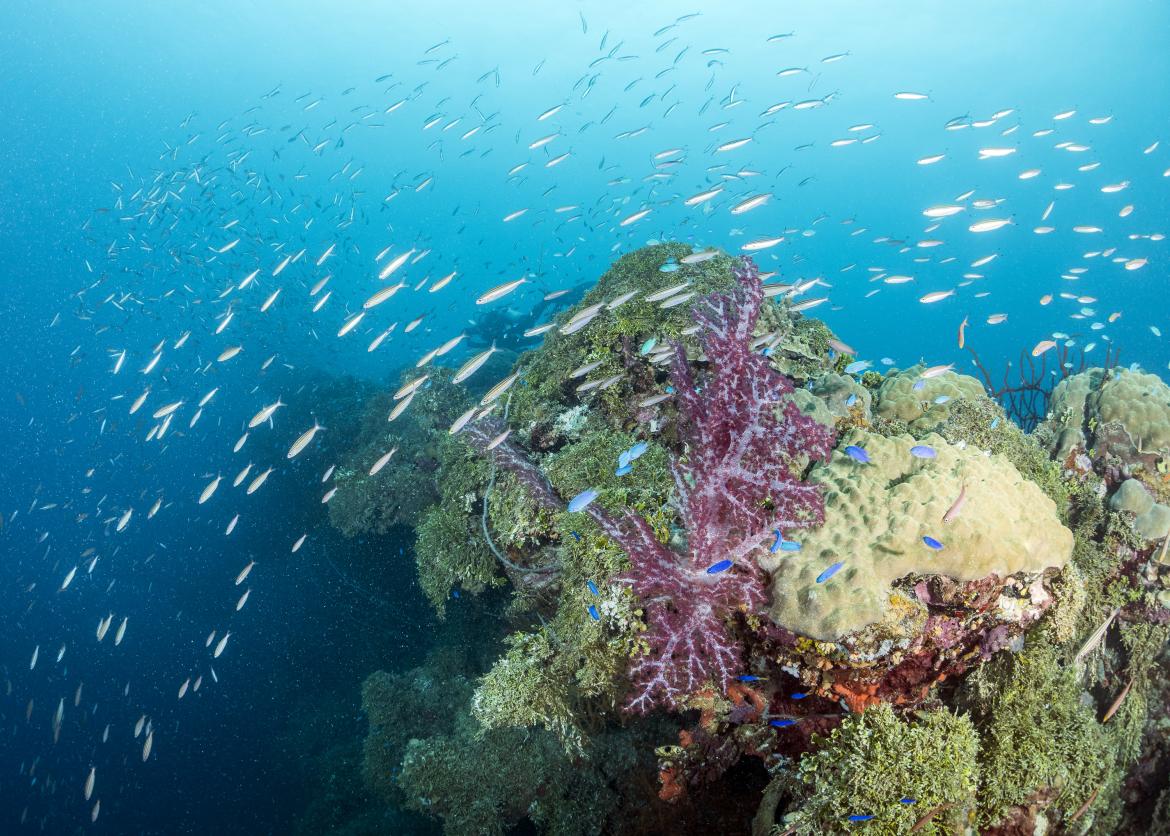
Kiyosumi Maru. The most impressive hard coral growth I encountered was on the 138m (453ft) Kiyosumi Maru, which lay in 33m (108ft) of water, on its port side. Dropping down the mooring line to the starboard railing at 12m (40ft), we saw the ship was indistinguishable, as the entire hull was covered in dome-shaped encrusting corals. It was not until we slipped over the edge to visit the hold or bridge, that the scene remotely resembled a man-made structure.
Once inside, the hold was filled with decaying 55-gallon drums, and the upper engine room had a large exhaust fan next to the doorway of a restroom, with attached porcelain sinks, a washtub and delaminated floor tiles. Since the wreck was on its side, one actually had to poke one’s head up vertically through the doorframe to see inside. There was also a symmetrical descending staircase leading to the lower engine room that one entered by swimming horizontally down the stairs, to discover a light fixture with an intact light bulb still in place.
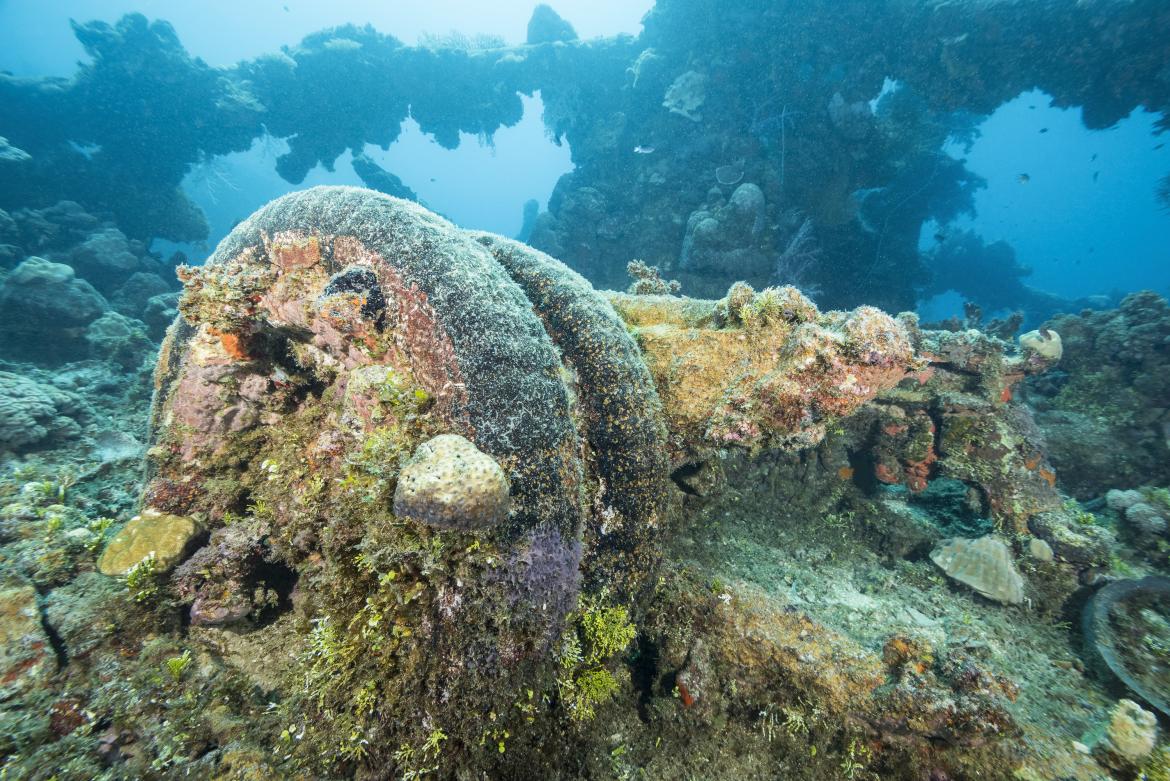
Sankisan Maru. A final favorite of mine from the trip was the 116m (380ft) Sankisan Maru, which split into two parts during its sinking, with the rear portion in much deeper water and rarely visited. The forward half was only in 24m (80ft) of water and had two large open holds containing three truck chassis, consisting mainly of their radiators, engines and frames. Inside were a pair of airplane engines, thousands of rounds of machine gun bullets, and countless small glass bottles hidden in the silt.
Up on deck were two more sponge-encrusted dually truck axles and a large school of pulsating glassfish. The king posts rose from the deck nearly to the surface, stopping at just 3m (10ft) deep and were fully immersed in multicolored sponges and soft corals. I spent the entire second half of the dive and all of my safety stop focused solely on shooting bio-clutter.
Afterthoughts
It would take a lifetime to investigate all the wrecks in the lagoon, and I can certainly understand why so many divers flock to Truk and continue to return year after year. My own content bias aside, the diving was absolutely fabulous and far exceeded even my expectations. I highly recommend a visit of your own, and I look forward to a return trip as soon as I can make it happen. There is so much more to see and explore! ■
Special thanks to Master Liveaboards (masterliveaboards.com) for hosting this adventure and to United Airlines (united.com) for their assistance with flights. The author would also like to thank Scubapro (scubapro.com) and Blue Abyss Photo (blueabyssphoto.com) for their assistance with underwater dive and photo gear.

